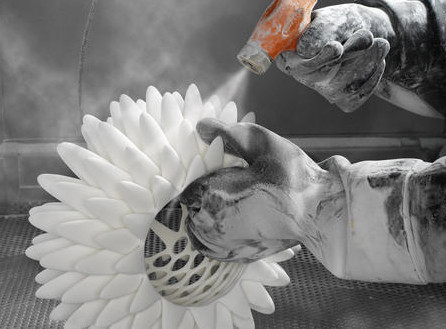
What is SLS 3D Printing ?
The 3D printing process in SLS may seem lengthy at first glance. However, when considering the printing time per object, SLS is one of the fastest additive manufacturing methods for producing serial parts.
A typical SLS build area can accommodate hundreds of parts simultaneously.
Objects can be printed on top of one another because the loose powder between the parts acts as support material.
In a 3D packing software, the parts are loaded, positioned, oriented, and packed.
This arrangement allows them to be densely packed andthree-dimensionally nested in the build space for maximum efficiency.
In technical terms, this is known as "nesting." The software simulates a shaking effect, ensuring that the parts optimally occupy the smallest possible print space without touching each other.
How does SLS 3D Printing Work?
The file containing the positioned parts is then loaded into a "slicing software." This software slices the object into layers of 0.1 mm and generates the machine code.
The software calculates the laser's path, taking into account the expected shrinkage during cooling after printing. The object is slightly larger in the code to account for this shrinkage, ensuring it has the correct size after cooling.
Once the machine reads the code, the powder material is loaded into the supply container. A slider or roller spreads a 0.1 mm thick layer and smoothes it out.
Then, the build chamber is heated to just below the powder's melting temperature.
Next, a laser fires from above onto the build bed, "drawing" the shapes in the powder. Since the chamber is preheated, the laser's energy only needs to add the final degrees of heat to precisely melt the powder in the right places.
The printing process is carried out under a protective atmosphere (usually nitrogen, N2) to prevent material oxidation.
Cooling and Cleaning
When dealing with sloped sections in the object, as with any additive manufacturing process, a stair-step pattern is created.
In SLS 3D printing, this pattern is less visible. When all layers are complete, the finished parts, along with the remaining powder, are within the machine's build chamber.
To prevent warping due to shrinkage, the parts slowly cool to room temperature while still "buried" in the powder.
Once the entire build area has cooled, the parts are excavated from the powder, and the unfused powder is prepared for the next print.
The parts are then cleaned using a glass bead blaster. The printed object is now ready for use.


Good to know


No Need for Support Structures in SLS 3D Printing
Because the laser has not consumed all its energy after 0.1 mm of material depth, it lightly re-melts the last layer.
If a layer melts, and there is no additional layer beneath it, it rests on loose powder capable of supporting its weight. This allows for the complete elimination of support materials in SLS 3D printing, enabling the production of complex geometries without compromising quality.
Mechnical ressiliance
The SLS process, characterized by laser-based printing, emerges as a stellar choice for fabricating components intended for long-term usage and resilience against mechanical stresses. Its distinct advantage lies in the near isotropic properties exhibited across all axes, making it particularly adept at producing mechanically robust parts, exemplified by the precision needed for components like life hinges. This technology's ability to ensure uniform material characteristics in multiple directions enhances the durability and structural integrity of the printed parts, elevating it to a prime solution for applications requiring both longevity and mechanical strength.
Applications
Aerospace Advancements:
SLS technology accelerates the development of complex aerospace components, from lightweight drone parts to intricate interiors, offering engineers rapid prototyping and cost-effective solutions.
Medical Marvels:
In healthcare, SLS facilitates the creation of custom medical devices, patient-specific cutting guides, and lifelike anatomical models, enhancing surgical planning and patient outcomes.
Environmental Responsibility:
SLS's use of recyclable materials aligns seamlessly with sustainability goals, enabling eco-friendly product creation and waste reduction.
